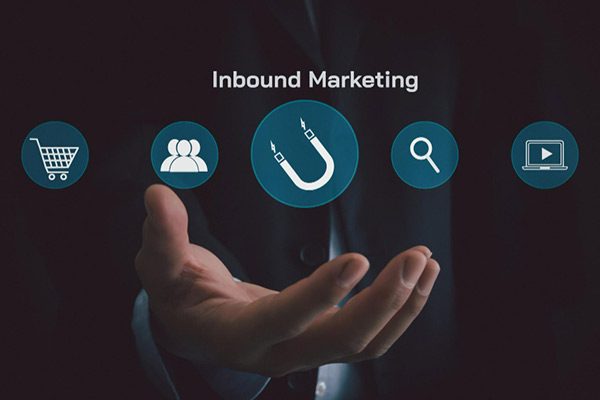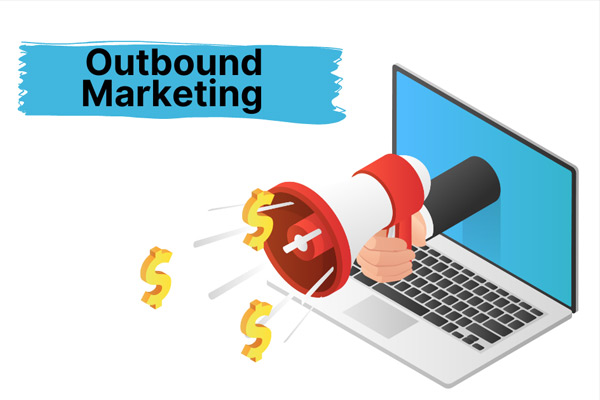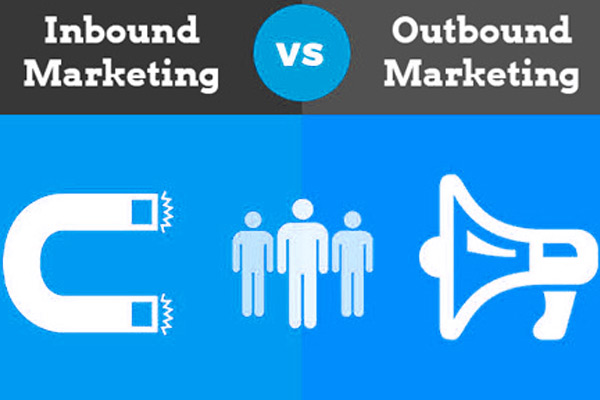Do you have a business and are thinking of ways to attract new customers?
You have no one where you need to be.
In this article, I tell you how to attract customers using marketing in an intelligent way.
To begin, I mention two general ways to attract customers through marketing: Inbound marketing and Outbound marketing.
Let’s take them one at a time.

Inbound Marketing
It’s a marketing strategy that focuses on attracting customers (with an emphasis on “attracting”) through relevant and useful content and interactions.
Basically, the purpose of this strategy is to focus on creating a positive relationship with the audience you are building by consistently providing value.
Let’s see some examples of inbound marketing to make it even easier to understand.
1. Blog content creation
It’s about what I’m doing now on my blog. I create relevant and useful blog articles for my audience. By doing this, you gain website visitors and notoriety. People see what and how you think and turn to you for help.
Inbound marketing is based on a fundamental marketing principle, namely: the principle of reciprocity. In short, if you give you will get something back in return because people feel owed directly or indirectly.
2. SEO – Search engine optimization
I have been and still am talking about SEO in the articles and materials I publish, including my guide to online marketing for beginners.
All you have to do with SEO is to make sure your website works well, is indexed by search engines, and frequently publishes relevant content that answers the questions and requests of all those who search for something on Google.
3. Social media marketing
It’s about using social media to increase your visibility online. In short, you post on social media (Facebook, Instagram, Linkedin, Twitter, etc.) and people will start following you after seeing your content.
Regarding social media marketing, it is necessary to post content on social media frequently and try to keep the engagement rate high with your target audience. So in short, if you see that certain types of posts are getting a lot of likes and comments, keep posting the same kind of content.
4. Email marketing
Again, this is something I practice because I send weekly newsletters to people who have subscribed to my list. I constantly publish valuable content on the blog but I make sure that I also maintain a close relationship with the people who follow me, providing quality content including through emails.
If you want to join my list and receive my weekly newsletter, click here and join for free.
The whole thing with this email marketing is relatively simple. In order for people to subscribe to your newsletter, you have to offer them something in return (sometimes it’s enough to tell them what they will receive in the following emails). But just growing your list isn’t enough. You have to learn to keep it active. That means sending emails frequently and making sure people actually read them and are interested in what you have to say.
5. Free Resources
Here are all the possible things you can think of:
- courses
- video recordings
- live webinars
- older webinar recordings
- pdf guides
- ebooks
- book
- infographics
You basically provide information that people need. Think about what people in your industry would like to know more about what you do or offer, then create such material for free. In this material, you can easily make people take more extensive actions (for example, to buy material for a fee or a subscription).
It’s all up to you and how much value you’re willing to give.

See the Full Strategy to 10X Your Business Growth
Discover the exact system that brought me clarity, premium clients, income, and freedom — without a team, without stress, and without burnout.
What are the advantages of Inbound Marketing?
Using Inbound Marketing you have many advantages including:
- increasing website visibility and traffic
- increasing the authority and credibility of your brand
- lead generation and conversions
- cost reduction
- increasing customer loyalty
What are the disadvantages of Inbound Marketing?
Inbound marketing requires quality content. Content is the key to inbound marketing success. That means creating valuable and relevant content on a consistent basis, which takes effort.
It takes time and patience to see results. Most of the time the results appear after several months of constant effort. It is precisely like the compound effect of financial investments. In the beginning, the amounts invested are small, but if you do this consistently for a good period of time, that active investment becomes passive.
It’s like the snowball effect that keeps getting bigger as you work on it. But of course, this means that you need patience, and most of the time it is not an advantage for a business that urgently needs customers.
You need to have technical skills. It involves using digital tools and technologies, which are not very easy for some people to use.
Increased competition can again be a problem, especially in an over-saturated market. Make sure you research the market before you start putting in the effort.
Finally, the last advantage of inbound marketing is the uncertainty of platforms and the frequent change of algorithms. You must always keep up and adapt to new trends to be successful.

Outbound marketing
Outbound marketing is a more traditional marketing approach that focuses on contacting potential customers through different methods and through different marketing channels such as: paid advertising, cold (ie unsolicited) phone calls, direct messages, direct emails , direct discussions.
The goal of outbound marketing is to make as many people as possible aware of a product or service through aggressive (sometimes even annoying) marketing methods.
Let’s see 5 concrete examples of outbound marketing to better understand what I mean.
1. Advertising through mass media
It refers to traditional advertising through television, newspapers, radio, magazines, appearances on TV shows, etc. They are listened to by a very wide audience.
We all know this form of marketing. It’s hard to measure the real impact, not being a form of online marketing, but it can have a powerful effect on expanding your business.
2. Unsolicited phone calls
They are usually made by agents who deal with this on a daily basis. Their role is to call companies or individuals. Their goal is to get the word out about a product or service and get an appointment or even a sale over the phone.
It’s a difficult and tough method that requires a lot of patience and nerves of steel.
3. Direct email
It refers to simply sending emails to a contact or a list of contacts. This form of marketing can be done relatively easily in the B2B (business to business) segment because there is no need for approvals and there are no laws to prevent you from sending.
This form of email can be beneficial especially if you follow up. That is, if you send a series of 4-5 emails. You have to be persistent until you get a response.
4. Outdoor advertising
It refers to advertising through posters on buildings or on various billboards (in bus stations, on shop windows, on cars, etc.).
And this is a form of outbound marketing.
5. Trade shows
Participation in various fairs and exhibitions where you display your stand or present your offer to a business or a wider audience.
What are the advantages of Outbound marketing?
- increasing visibility
- targeting specific audience segments
- possibility of effective measurement of campaigns (for example, tracking phone calls or emails)
- rapidity
- flexibility due to the variety of communication channels
increase conversions

Join our community
What are the disadvantages of Outbound marketing?
Although outbound marketing can be an effective method to reach a large audience and generate quick sales, there are also some disadvantages that you need to consider.
The costs are high and quite difficult for small businesses or startups to bear.
Outbound marketing campaigns are considered intrusive (perceived as irritating) and can quickly annoy people and tarnish your brand image.
Also the effects are limited. Even if there is massive growth at the moment, it is temporary and not sustainable in the long term.
Although we can measure certain outbound marketing results, most campaigns that are done through this marketing strategy are difficult to monitor. It is difficult to define how many people see the advertising posters on a building for example, especially in the era of distraction (people can look at a poster without even seeing a “grain” of what is written on it).
It is also difficult to reach the target audience because the audience usually ignores TV ads, which results in ineffectiveness (campaigns have to be super well done to have the desired impact).

What to choose between Inbound and Outbound marketing?
Now that I have clarified what each of the 2 strategies represents, I have given examples, we have advantages and disadvantages, and the question comes: what should I choose?
Well, there is no one-size-fits-all recipe for success, that’s for sure. But I can tell you the following things with certainty:
It matters a lot what type of business you have and what stage you are at. You need to analyze your business and choose the option that suits you best at the moment. If you also have a long-term strategy or vision, clearly inbound marketing is the perfect long-term solution.
The problem occurs at this point. What do you do now if you need customers?
Are you calling outbound?
Of course…it depends.
However, I personally recommend a hybrid version. As much as possible, at the beginning of the journey, I would say to push as hard as you can on inbound (including investing in a paid online promotion that will give you a boost to your accounts and website).
In parallel, if you have a product or provide services and want to sell quickly, try the classic outbound options: private messages, phone calls, and emails.
Don’t be afraid of rejection. You need at least 100 NOs before changing your approach. The approach is critical and you should expect to get a lot of negative responses. But stay motivated, and keep going until you get your first “YES”. One “Yes” makes as many as 100 “Nos”. The feeling is very lovely and all the work beforehand is part of the process.
If you need more help deciding, schedule a chat with me here.






